Hard to believe that it is already 20 years today that “9/11” happened, the terrorist attacks by means of hijacked passenger planes that were steered into the Pentagon in Washington (well, Arlington, just outside the city to be precise) and the Twin Towers of the World Trade Center (WTC) in New York City, USA.
“Ground Zero”, the site of the collapsed WTC, and later the dedicated National 9/11 Memorial and Museum have become one of the most visited dark-tourism sites in the world. There’s no need for me to provide background information about what happened – everybody more or less knows the story well enough. So I’ll just concentrate on the DT experiences, and only look at New York:
I’ve personally been to “Ground Zero”, i.e. the area around where the WTC used to stand, three times. The first time was less than a year after it had happened, in August 2002, i.e. even before the first anniversary. At that point, the whole drama and tragedy was still very fresh and raw. I remember how it hit me as I exited Grand Central Station and came across a whole wall covered with missing notes – that is people still “looking for” loved ones who by then had to be presumed dead. Yet so many had not been identified at that point. In fact identification of human remains continues to this day … only a few days ago I read about two more victims having been identified by forensics methods. Nearly twenty years after the event!
Back in 2002 I then visited the actual “Ground Zero” site. At the nearby St. Paul’s Chapel on Broadway, the fence around the churchyard perimeter was completely filled with missing notes, mementoes, flags, and whatnot. Thousands of pieces. It was very sobering indeed. Here’s a photo from back then:
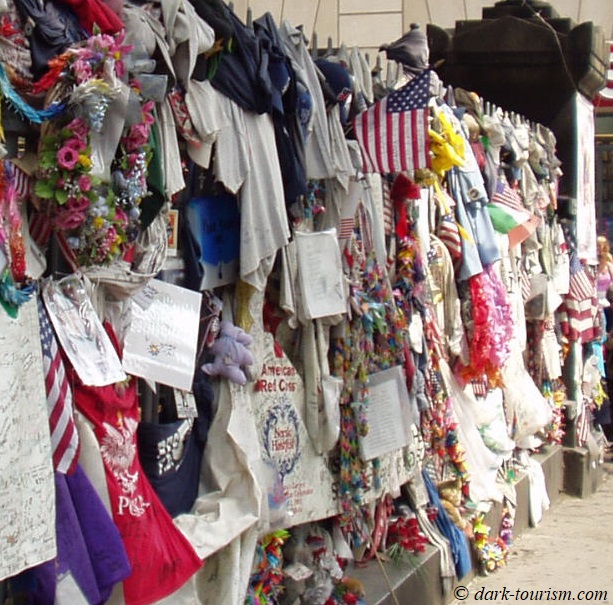
On the other side of the chapel’s grounds facing Church Street early forms of commercialization had appeared. Souvenir vendors offered all manner of wares, from “Ground Zero” baseball caps, to postcards, paintings, brochures and some really unbelievable tack such as snow globes with a little WTC inside and a firefighter truck at the bottom. Utterly tasteless – but I admit I actually bought one (plus a cap), if only to have proof that such things actually existed. (One day I’ll make a post featuring my most dubious DT souvenirs I have in my collection …) Here’s a photo from the corner where I witnessed this:
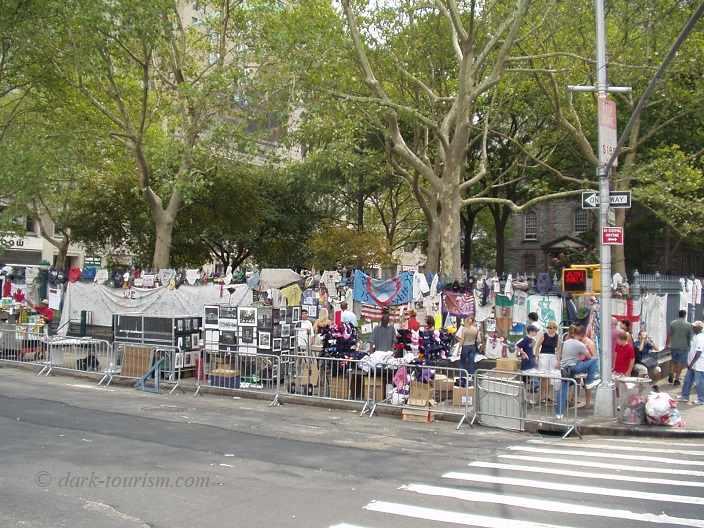
The actual site of the WTC was inaccessible at that time. But one could peek through fences to see that the place was basically just a big hole in the ground. Early construction work was ongoing, but it was clear that this would take many years.
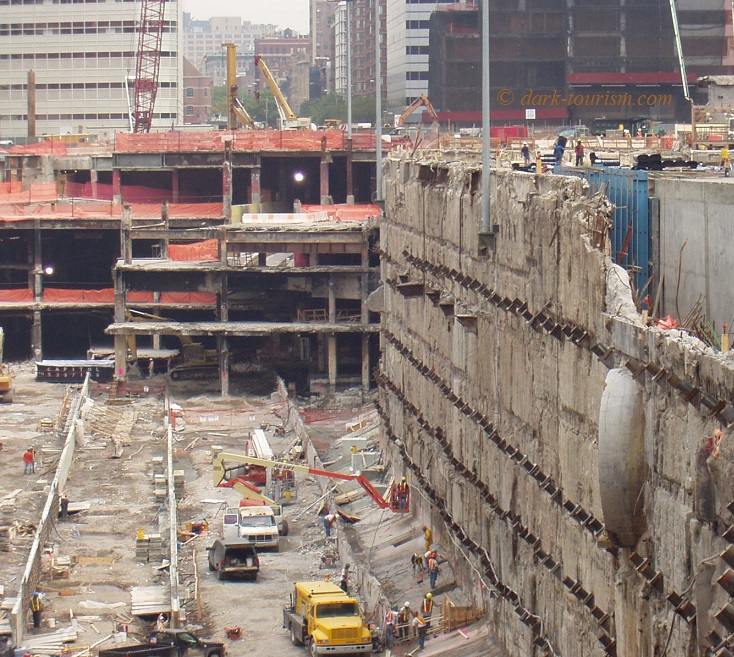
I also saw that big hole from the air, namely from a scenic helicopter flight around Manhattan (my first ever helicopter flight – taking off backwards was quite some experience!).
My second visit to New York was almost eight years later, in 2010 around Easter time. “Ground Zero” was still a building site then, though a couple of new towers had already been completed. The new One World Trade Center was in an early stage of construction, it’s steel frame about 40-50m high at that point, so less than a tenth of its eventual height. And the National 9/11 Memorial hadn’t opened yet (it was also still in the making then).
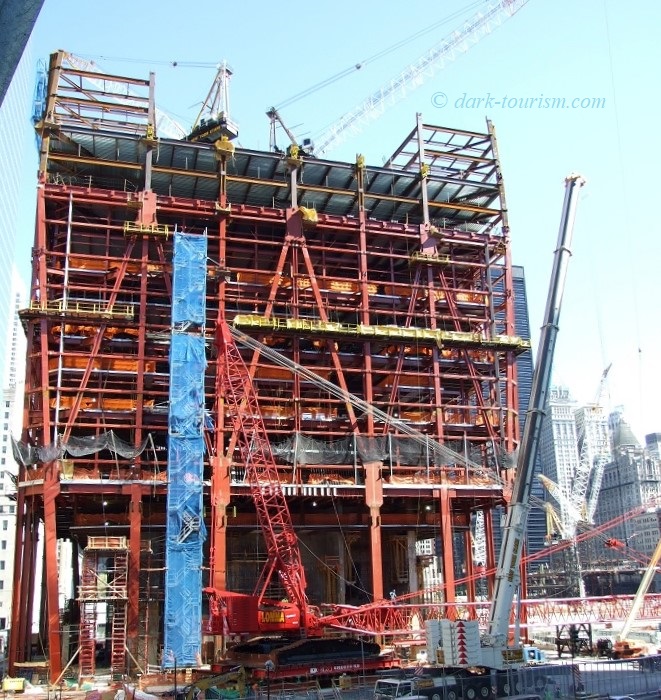
The commercialization had been steered into more regulated directions, so instead of “wild” souvenir vendors there was now a “9/11 Memorial Preview Site”, which apart from being home to a photo exhibition and featuring a model of the future site functioned mostly as a shop, selling both somewhat less tacky souvenirs and numerous books.
At St. Paul’s Chapel the thousands of mementoes and notes had disappeared, but inside the church was an exhibition that incorporated some of the items that used to be left at the fence, including a collection of soft toys. Amongst them I found this fluffy firefighter teddy bear:
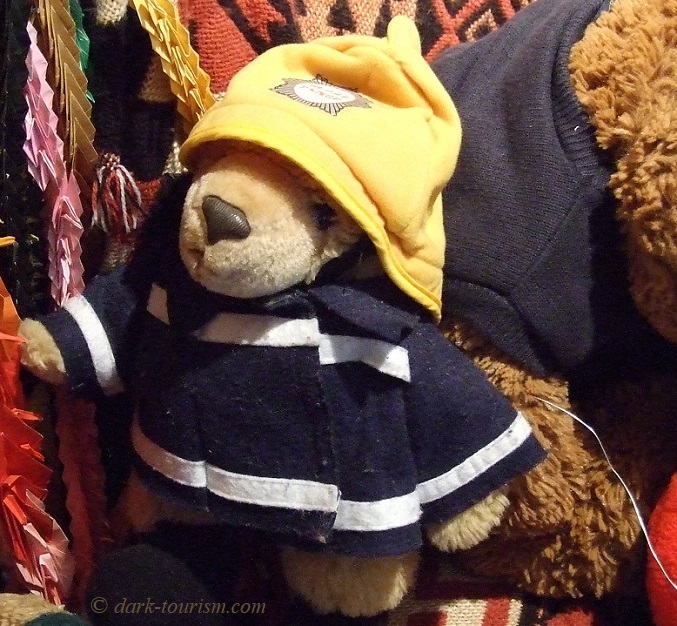
Another one was presumably meant to look ‘patriotic’, going by the attire in the national flag style, but I thought it looked a bit like a cross between Bruce Springsteen and Charlie Chaplin (or someone else with a similar moustache style):
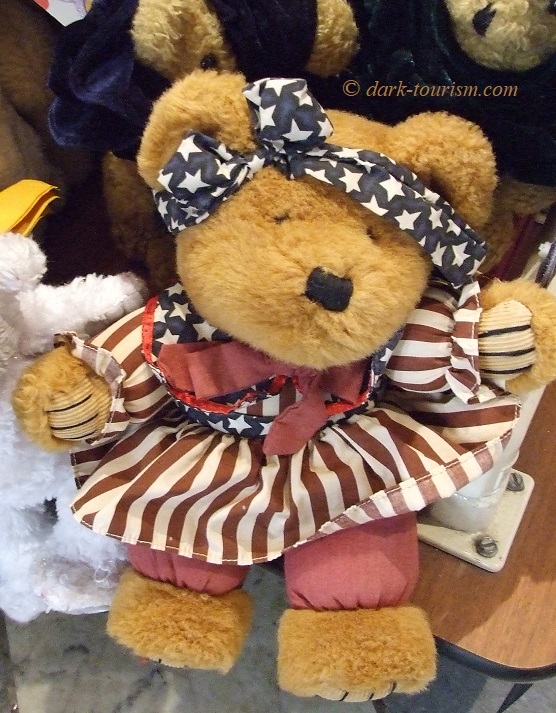
On the side of the local fire station a new mural, or rather bas-relief, had appeared, which featured various scenes from that fateful day in 2001, including a depiction of the WTC North Tower on fire and the South Tower just having been hit by the second plane. I found this also rather borderline kitschy (same photo as the featured one at the top of this post):
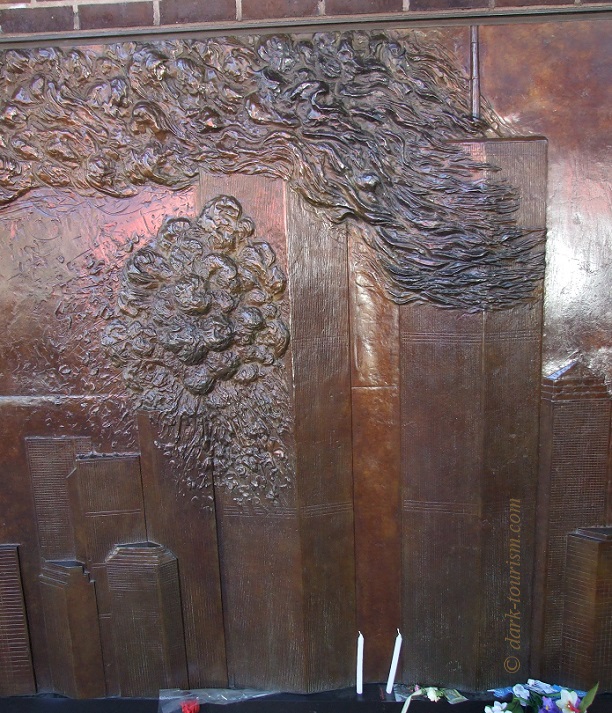
The most organized commodification of the 9/11 tragedy in 2010 came in the form of the Tribute WTC Visitor Center next to the fire station. This was a formal exhibition and meeting place, incorporating some exceptional exhibits. Amongst these was this mangled window from one of the planes that were steered into the Twin Towers:
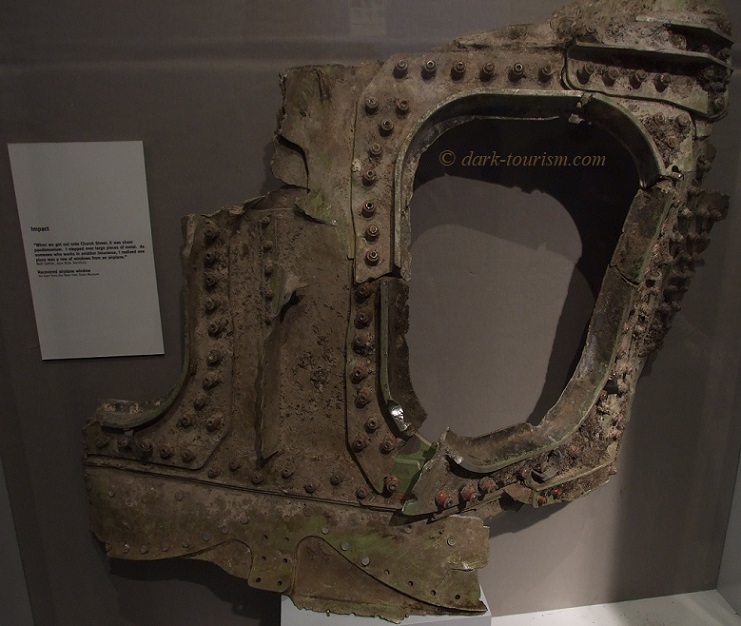
What made the Tribute WTC stand out the most, however, were the walking tours they offered, all led by volunteers who in some way were directly affected by 9/11, be it survivors, those involved in the rescue operation, relatives of victims who perished in the towers or in the rescue efforts. The group I joined was led by a man who had lost a brother at the WTC who was in the police, but there was also a guy who had joined the volunteers at Tribute WTC only recently, and we were the audience that he told his story to for the first time. He was a teacher at a school just one block from the WTC – kids on the upper floors witnessed the first plane hitting the North Tower! They began to evacuate the school but it took a while. This teacher was the last to leave the building and began leading his group of students towards Battery Park – just as the South Tower collapsed. They were all engulfed in the cloud of dust and debris from the collapse and lost orientation and each other, only to eventually regroup at Battery Park. The former teacher said he still suffered from lung problems brought about by the asbestos and chemicals from the WTC dust cloud. What a story. We felt very privileged to have been at its public premiere!
The third time I was in New York was in the summer of 2015 (my fifth trip to the USA in total). The 9/11 Memorial had meanwhile been completed (in 2011) and the associated National 9/11 Museum had opened just the year before in the second half of 2014. The Tribute WTC Center was still there – but I’ve meanwhile found out that it has since moved further down the road and has been renamed “9/11 Tribute Museum”. The exhibition has been expanded, and the guided walks with volunteers are still being offered.
At St. Paul’s Chapel I found that the former exhibition there was reduced to just a fraction of what it was before in one corner of the church only. The rest, I presume, will have been distributed between the other two museums. The “Preview” site was also still there in 2015, even though the National 9/11 Memorial had long opened. It still served mainly as a shop. Whether this is still in place I haven’t been able to establish yet. In a way I reckon it’s now redundant and thus would expect it to eventually disappear if it hasn’t done so already.
The main new thing for me to explore in 2015 was, naturally, the memorial site and the new main museum.
The main 9/11 Memorial site incorporating the two “footprints” of the WTC Twin Towers has become an iconic landmark of New York City and is well known. Here’s a photo nonetheless:
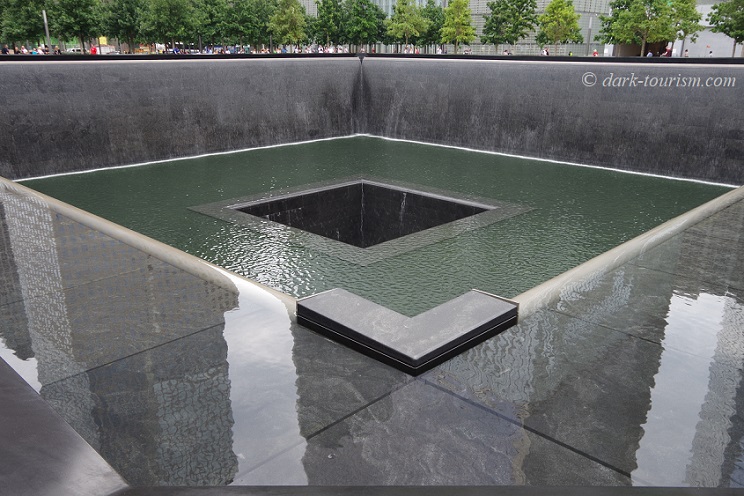
The key attraction of the whole site, though, is the National 9/11 Museum. This has often been severely criticized, but I’m prepared to defend it. In fact I rate it as the world’s top dark museum. The critics bemoan the high admission fee – which is hefty, but by US standards still within reason (other US attractions, e.g. the fabled San Diego Zoo, charge a lot more) – and they also complain about too much commercialization. The museum shop is indeed large and does have plenty of items on offer that are perhaps not the most tasteful, BUT: unlike at so many other museums you do not have to exit through the shop but are free to choose to ignore and bypass it! That way the commercialization is entirely voluntary. That’s an important point that is too often not taken into account. Some critics also find fault with the high level of emotionalization and displays of patriotism. That does indeed sometimes feel a bit heavy-handed for non-Americans, but is a) to be expected in this place, given the significance of 9/11 for the nation, and b) this only applies to parts of the museum outside the main historical permanent exhibition. And I would argue that this exhibition really constitutes the heart of the whole complex and hence should also be the main focus when arriving at any overall value judgements. In my view this exhibition is absolutely top-class. It’s also largely free of forced emotionalization, but very factual instead. It covers every aspect of 9/11, the run-up to it as well as the aftermath, all in incredible detail. I spent hours in there and at the end had to rush because I was meeting friends at a restaurant and didn’t want to be late for that. One can easily spend at least six hours in this exhibition part alone! (Admittedly, though, most visitors go through it in about two hours, but that allows only a superficial impression.)
Some aspects of the museum have been criticized as well – e.g. the display of a piece of “composite”. That’s the term they use to describe the compacted mass of debris compressed by the weight of the collapsed towers. In this tangled mass it is not unlikely that tiny bits of pulverized human remains may be present (not visible to the naked eye, though) and some therefore see this display as unethical.
One audio station plays a recording of a cockpit announcement made by one of the hijackers, Mohammed Atta, intended to calm the passengers down just after the hijacking … and before he steered the plane into the North Tower (he obviously didn’t announce that). This piece of authentic evidence is indeed eerie to listen to, but I think it’s important. Some criticized that it immorally “gives the perpetrator a voice”. I can’t see it as in any way justifying the attacks though. It’s just part of the real story and hence plays a role here too.
One controversial section of the exhibition consists of a semi-separate alcove that came with a warning at the entrance – as it has video footage of the “jumpers” (i.e. those who chose to jump from the North Tower rather than slowly dying from smoke inhalation or burning to death inside the building). But, as with the shop, visitors have the option of bypassing this element if they wish. The footage shown is not that graphic anyway, just the tumbling dots seen from a distance, as was also shown on TV, but nothing of the end result (which would indeed have been highly problematic).
Photography inside the main exhibition was unfortunately prohibited (and it was policed), so I can’t show you anything from in there. But here are a couple of photos from the parts of the museum outside the historical exhibition. Most of the museum is underground, but in the small above-ground foyer a large artefact greets you that is immediately recognizable as one of the base steel columns from the WTC:
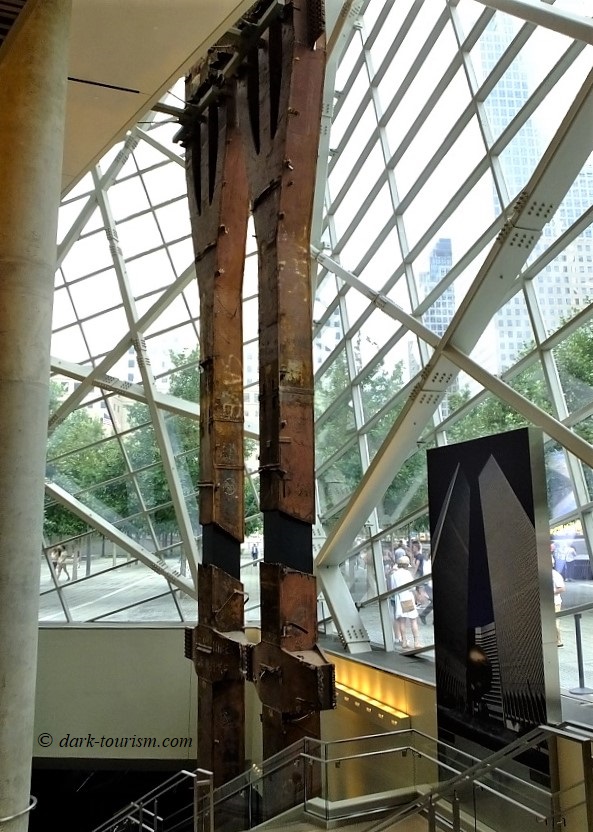
More mangled steel girders are on display inside, including one pair of such steel pieces by the wall that surrounds one of the towers’ footprint basins. A photo and chart explains that these pieces came from between the 93rd and 99th floors of the North Tower, from the centre of the “zone of impact”, i.e. they were ripped apart by the nose of the aircraft piercing its way inside …
Another dramatic large exhibit is a partially mangled fire engine that was damaged by falling debris from the collapsing towers:
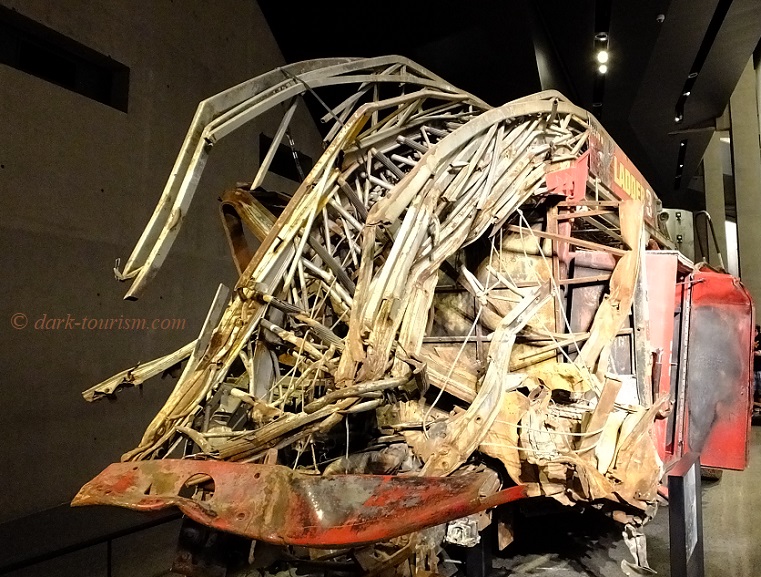
But let’s finish this post on this tragic anniversary day on a higher note, as it were (even literally). Here’s a photo of the completed One World Trade Center tower, which is now the highest in the western hemisphere, about 10% taller than the WTC was:
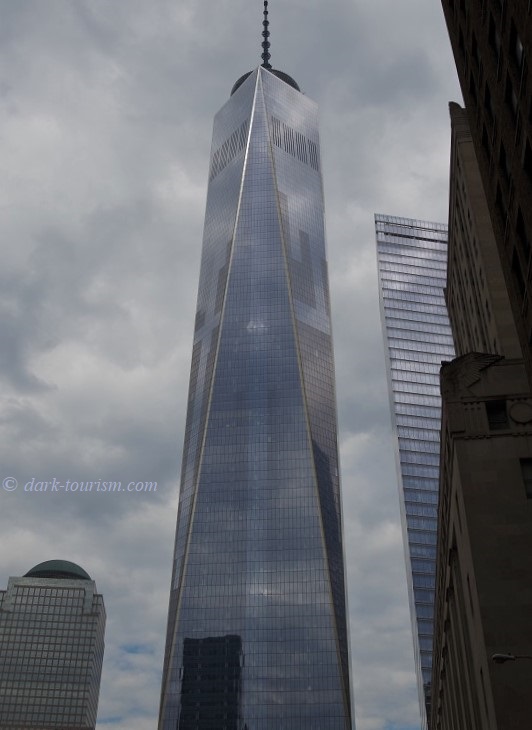
Meanwhile other structures around the former “Ground Zero” will also be completed, but I haven’t seen those yet. It’s been over six years since my last visit and I hope that I can go back to the USA at some point in the coming years. Some parts of the country I haven’t yet seen at all, such as the Deep South (and there’s plenty to see there now that’s related to the age of slavery and the Civil Rights movement). But a return visit to New York, including “Ground Zero” and the 9/11 Memorial & Museum, would naturally be on my list as well. It’s such a thrilling city.

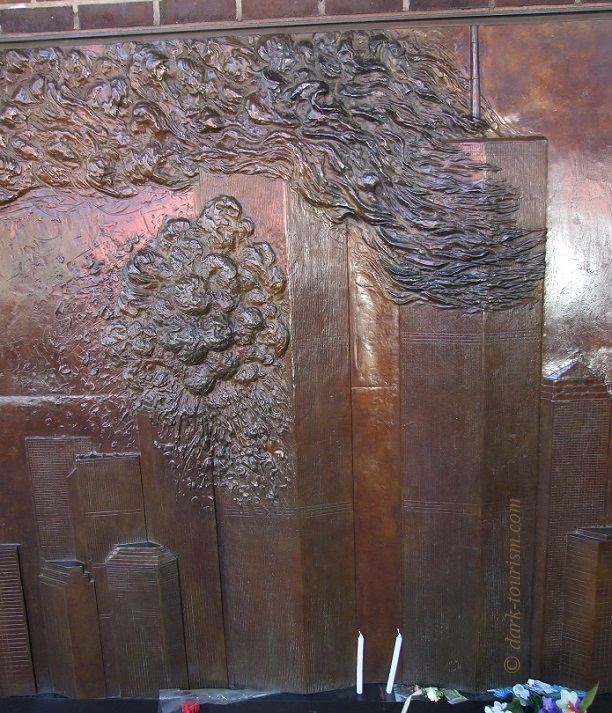



2 responses
Thanks again Peter for such a great blog. I visited the site in November 2011 and again on the 1st and 2nd anniversaries but haven’t been back since. It is only a 4 hour drive from my house and after reading your blog I will be going soon.
yes, do go, and take your time in the main exhibition. It’s amazingly detailed. It’s emotionally taxing, no doubt, but also very rewarding!